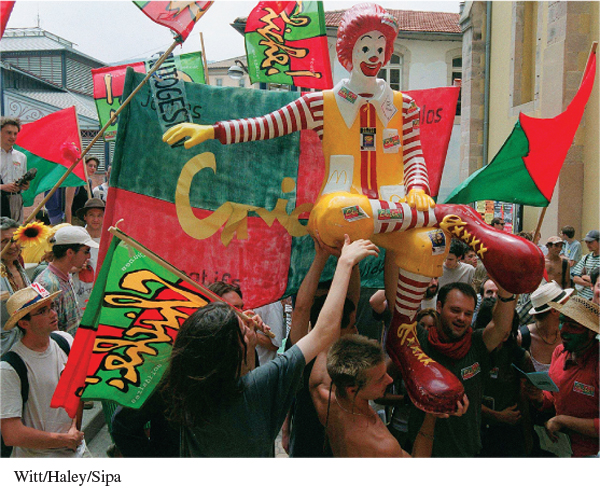A History of Western Society: Printed Page 1033
A History of Western Society, Value Edition: Printed Page 994
A History of Western Society, Concise Edition: Printed Page 1037
The Human Side of Globalization
Globalization transformed the lives of millions of people, as the technological changes associated with postindustrial society (see Chapter 29) remade workplaces and lifestyles around the world. Low labor costs in the industrializing world — including the former East Bloc, Latin America, and East Asia — encouraged corporations to outsource labor-
The outsourcing of manufacturing jobs dramatically changed the nature of work in western Europe and North America. In France in 1973, for example, some 40 percent of the employed population worked in industry — in mining, construction, manufacturing, and utilities. About 49 percent worked in services, including retail, hotels and restaurants, transportation, communications, financial and business services, and social and personal services. In 2004 only 24 percent of the French worked in industry, and a whopping 72 percent worked in services. The numbers varied country by country, yet across Europe the trend was clear: by 2005 only about one in three workers was still employed in the once-
The deindustrialization of Europe established a multitiered society with winners and losers. At the top was a small, affluent group of experts, executives, and professionals — about one-
In the bottom tier — in some areas as much as a quarter of the population — a poorly paid underclass performed the unskilled jobs of a postindustrial economy or were chronically unemployed. In western Europe and North America, inclusion in this lowest segment of society was often linked to race, ethnicity, and a lack of educational opportunity. Recently arrived immigrants had trouble finding jobs and often lived in unpleasant, hastily built housing, teetering on the edge of poverty. In London, unemployment rates among youths and particularly young black men soared above those of their white compatriots. Frustration over these conditions, coupled with anger at a police shooting, boiled over in immigrant neighborhoods across the city in August 2011, when angry youths rioted in the streets, burning buildings and looting stores.
Geographic contrasts further revealed the unequal aspects of globalization. Regions in Europe that had successfully shifted to a postindustrial economy, such as northern Italy and southern Germany and Austria, enjoyed prosperity. Lagging behind were regions historically dependent on heavy industry, such as the former East Bloc countries and the factory districts north of London, or underdeveloped areas, such as rural sections of southern Italy, Spain, and Greece. In addition, a global north-
The human costs of globalization resulted in new forms of global protest. Critics accused global corporations and financial groups of doing little to address problems caused by their activities, such as social inequality, pollution, and unfair labor practices. The Slow Food movement that began in Italy, for example, criticized American-

The general tone of the antiglobalization movement was captured at the 1999 meeting of the WTO in Seattle, Washington. Tens of thousands of protesters from around the world, including environmentalists, consumer and antipoverty activists, and labor rights groups, marched in the streets and disrupted the meeting. Comparable demonstrations took place at later meetings of the WTO, the World Bank, and other supranational groups.
Similar feelings inspired the Occupy movement, which began in the United States in 2011 and quickly spread to over eighty countries. Under the slogan “We are the 99 percent,” thousands of people camped out in (or “occupied”) public places to protest the rapidly growing social inequality that divided a tiny wealthy elite (the “1 percent”) from the vast majority of ordinary people. Though the diverse groups in the Occupy movement failed to mount a sustained and successful challenge to the public officials and business leaders who profited from globalization, their calls for greater social equality and democracy showed that the struggle for reform continued.